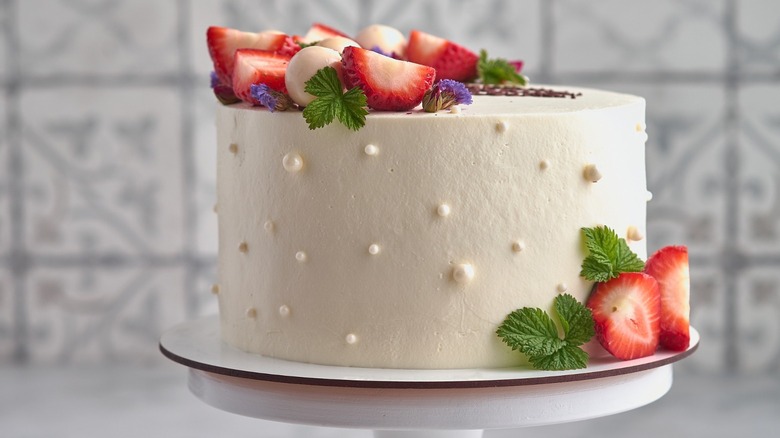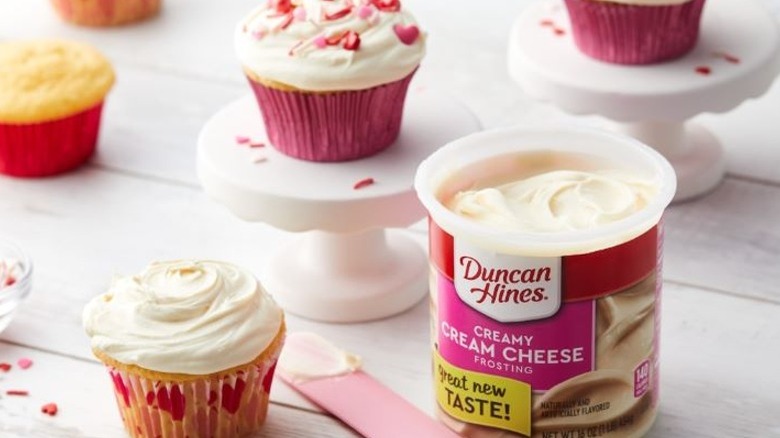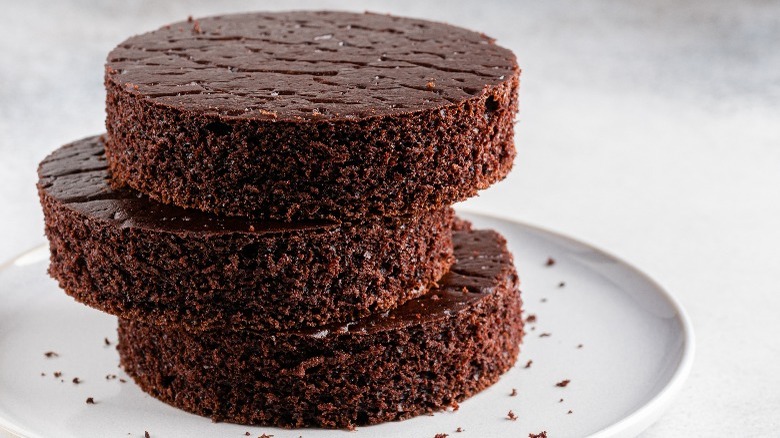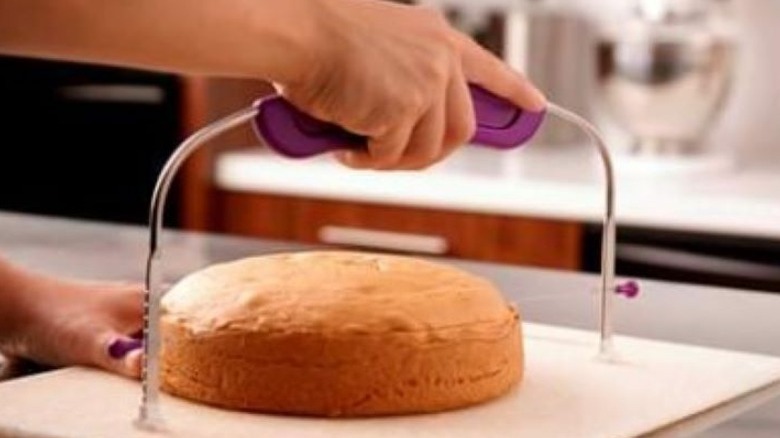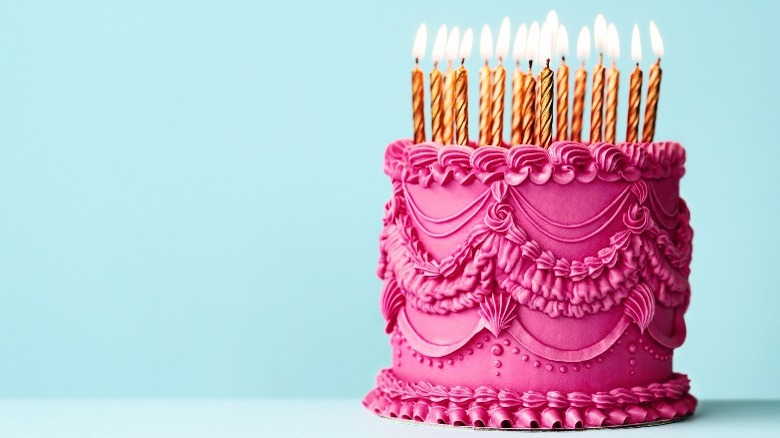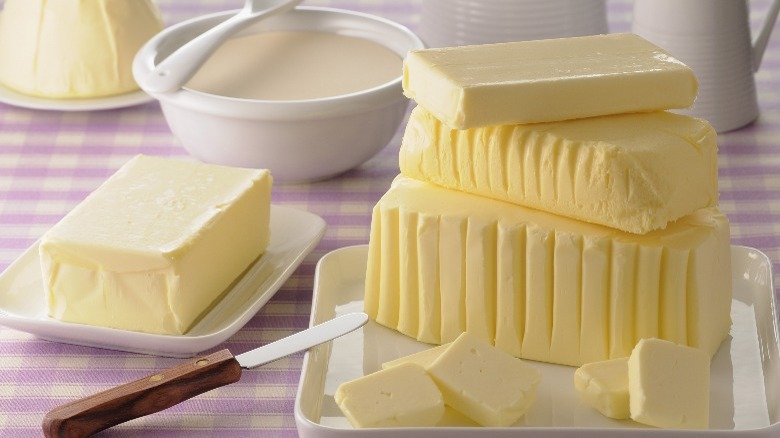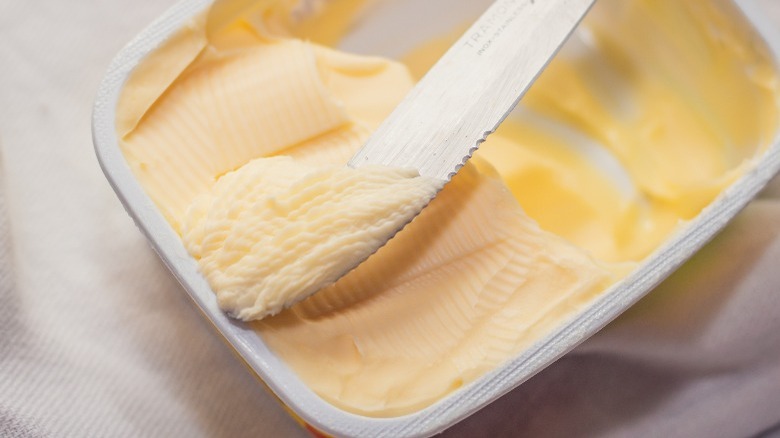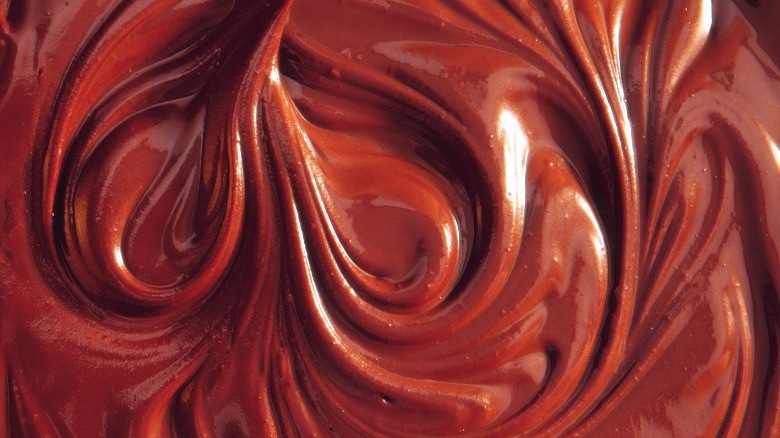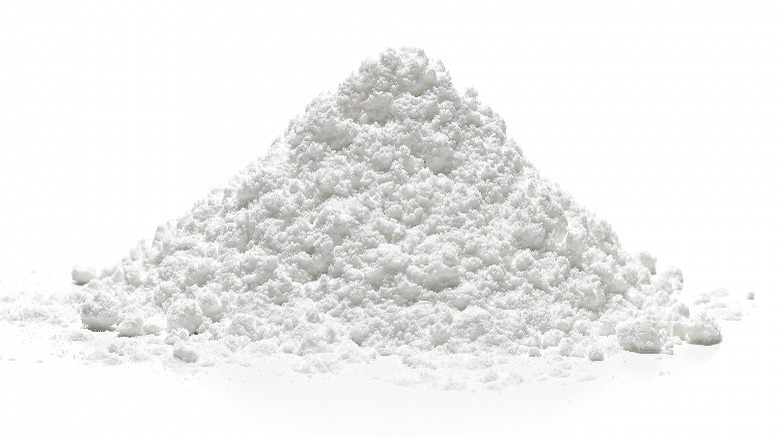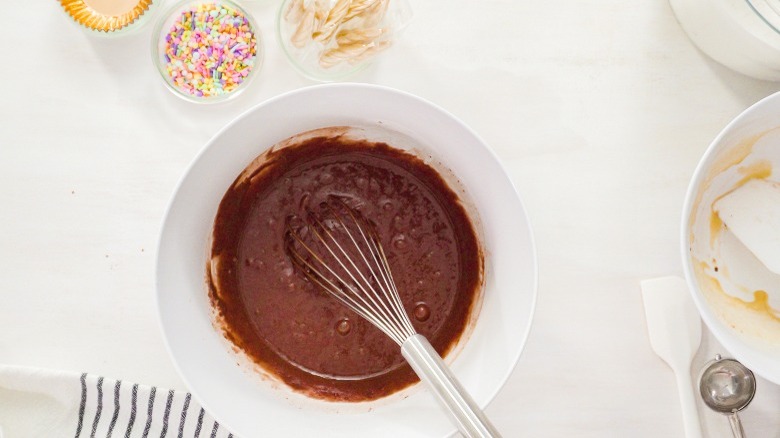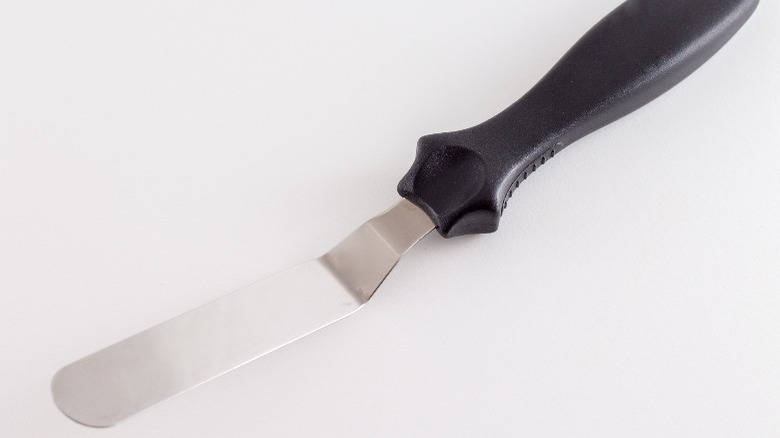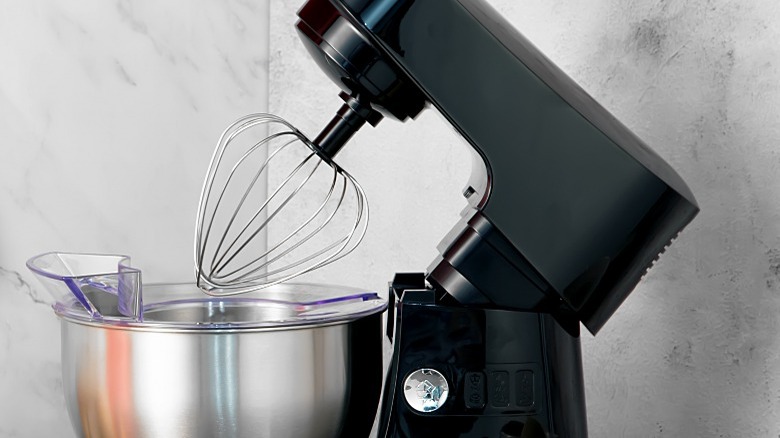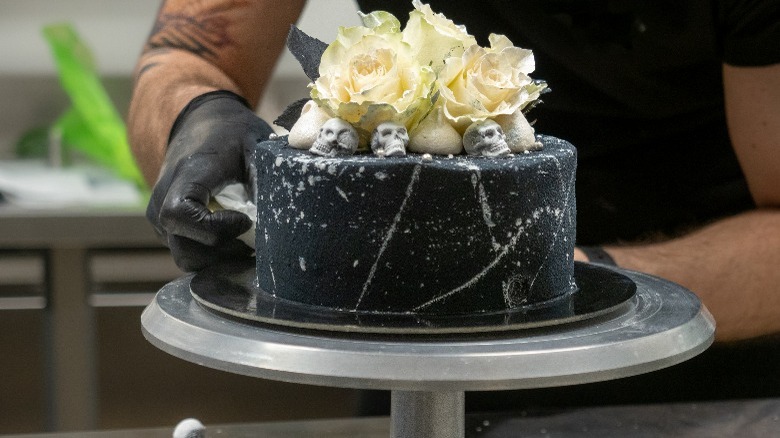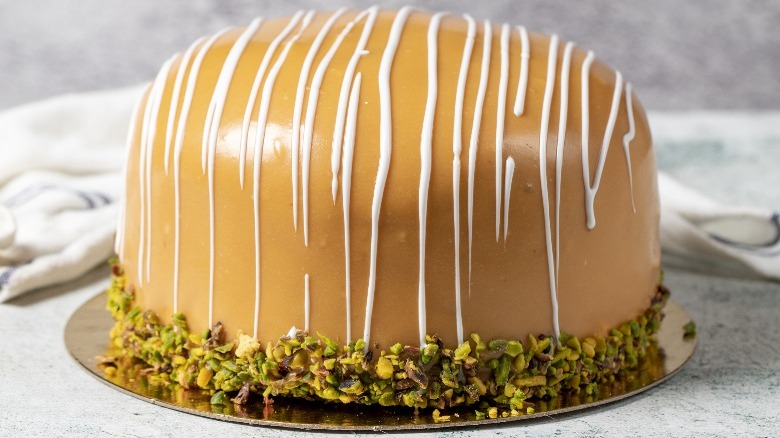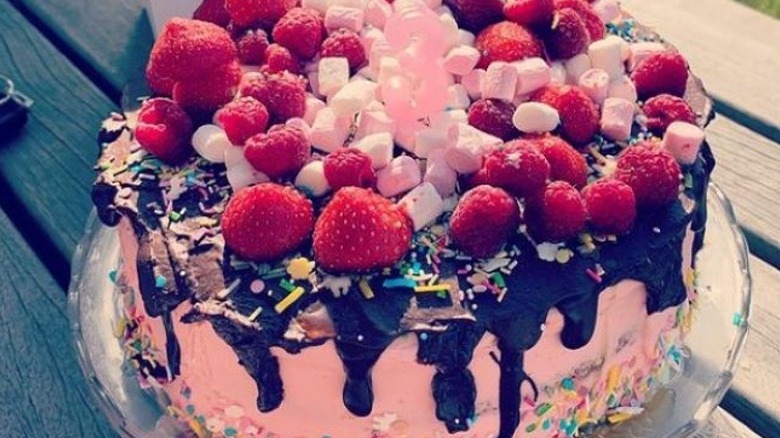15 Cake Frosting Mistakes You Might Be Making
We may receive a commission on purchases made from links.
A homemade cake always wows dinner guests, but sometimes a common frosting mistake can throw everything off. The error can be a wrong choice of ingredients, not using the right tools, being afraid to step out of the box, or plain old impatience. Unlike making a quick apple crumble, a beautifully prepared and frosted cake can't just be thrown together at the last minute. Everyone's attention will be focused on this dessert when it's brought to the table, so you'll want it to look and taste amazing.
A lot of things can go wrong with homemade frosting, so it makes sense to allow enough time and put in the effort to get it right. And it's never a bad idea to have extra ingredients on hand, especially when the cake is for a special occasion. These errors explained below are common ones often made by rookies and more experienced bakers, so don't judge yourself too harshly if they seem familiar. It's a learning process and once you get the hang of it, you'll look forward to frosting cakes for yourself, your family, and your friends. Here are 15 frosting mistakes to avoid.
1. Using canned frosting
A 16-ounce can of Duncan Hines frosting costs less than two bucks, and there's no debating that it will save money and time. But it just can't compare to the taste of homemade frosting. The real thing is made with sugar and items like cocoa, vanilla extract, cream cheese, and fruit. The canned stuff has some of these, plus chemicals like sodium acid pyrophosphate, potassium sorbate, and tocopherols. We're not sure what most of those are, and they have no place in frosting. Oh, and canned frosting also has artificial flavor.
These products tend to taste bland and can also be on the thinner side. Although you can't control the ingredients put in the cans by manufacturers, it is possible to doctor this frosting up by adding whipped cream, flavorings, nuts, and other ingredients. But these are shortcuts and the frosting will taste like it's masquerading as the real deal. Skip the cans and make the frosting yourself unless you're baking cupcakes for the whole class.
2. Frosting the cake before it's cooled
It's never easy to wait for a baked cake to cool completely before frosting, but not being patient guarantees disaster. That's because cakes are not firm enough when they are still warm, and frosting them too soon will cause the surface to crumble up. The layers might also develop fractures, and there's more: the warmth could cause the frosting to melt and run off the cake.
Before making frosted cakes, always plan ahead to allow for cooldowns — this step cannot be rushed. Although the results vary, let the cake rest for at least two hours on cooling racks before frosting. Gently press down on the tops of the layers and if there is any warmth at all, give them more time. The layers should feel cool to the touch before being frosted. Another option is to wrap them in non-cling plastic and put them in the fridge for two hours or overnight.
3. Forgetting to level out the layers
After cake batter is poured into pans, the tops of the layers puff up into subtle or more obvious dome shapes; compare this to bakery cakes, which have flat tops. Those curves can throw things off when a top layer is placed on top of a bottom one. Sure, you can turn the layers upside down to have the flat sides facing up, but unless they're leveled off, the cake won't be straight and even and might start to lean or wobble.
To prevent an awkward appearance, level the cake tops off before frosting. This can be done with a long bread knife or cake leveler. Look at the cake straight on instead of from below or above and slice it perpendicularly from the top of the dome, starting with a small shave. Look at it all the way around and remove some more until the top is flat. Do the same with the other layers.
4. Being afraid to upgrade
There's nothing wrong with chocolate or vanilla frosting, but a little bit of creativity can go a long way. A fruit-flavored frosting is a pleasant surprise and doesn't need that many more ingredients. One example is a tangy orange-lemon buttercream. This can be made with the usual items, but instead of basic flavorings, add orange juice, lemon juice, and zest. To make homemade caramel frosting, boil the butter and sugar first before adding the other contents — a bit of sea salt will turn it into salted caramel. Yum.
Homemade frosting can also be upgraded with cola, cherry soda, food coloring, or freshly chopped strawberries. Freeze-dried fruit powder can also change the flavor, or you can mix in Grand Marnier liquor, peanut butter, or jam. There are also great ways to add texture — think about chocolate chips, toffee bits, or nuts. Just put in a little bit at a time and mix gently after each addition. In most cases, about one cup will be enough to enhance the frosting without overwhelming it. You can also use these to decorate the cake when finished — don't forget about the sides.
5. Not letting the butter soften
Most frosting recipes use at least one stick of butter, and it must always be softened and never melted, with no exceptions. It stays in a solid form at room temperature, but since it contains air, it is whippable. Air pockets form when it gets whipped with sugar, and this is necessary to aerate the cake batter. Before being incorporated into the batter, butter should be in semi-solid form. If you aren't sure, do the finger test. Press a finger onto the top and if there is no resistance and an imprint left, it will be ready to go. If it's shiny, it has passed into the semi-liquid stage.
Depending on the temperature inside the kitchen, butter can take up to an hour to soften and longer if frozen. Planning ahead of time is crucial. The USDA posts that butter can be safely left on a counter for a day or two, but don't leave it out any longer. Many bakers take it out of the fridge or freezer the night before they plan to bake.
6. Using margarine instead of butter
When it comes to baking, margarine can't beat the taste of butter. And this makes perfect sense because margarine is mostly made from oils containing unsaturated fat. Regular butter is a dairy product that is churned from milk or cream. Tub margarine has less saturated fat than the stick versions, and anyone who uses spread margarine in frosting is asking for trouble.
The saturated fat in butter provides the best flavor and better texture in baked goods. Margarine might also have more water, which could make frosting runny. Avoid using it in frosting unless you have no choice, but don't expect it to have the same taste. But if you're making buttercream and frosting, there can be no substitutes. Head to the grocery store for sweet butter or don't make the frosting. And always use the unsalted kind for baking because there's no need for the added sodium, except for, of course, salted caramel frosting.
7. Using cold frosting
It might initially make sense to ready the frosting while the cake is baking or even sooner, but this is another common mistake. It tastes best when fresh, and since the prep doesn't take that long, the best advice is to make it and frost that cake as soon as it's cooled. Buttercream frosting can be prepared one or two days in advance and stored in the refrigerator in tightly sealed containers. Don't make cream cheese frosting more than a few hours ahead of time, though. Other frostings won't last long either, because the textures and tastes will quickly start to change.
Take made-ahead frosting out of the refrigerator while the cake layers are cooling because if it's not at room temperature, it won't spread well. It also becomes dense when chilled, so take out an electric hand mixer and fluff up the frosting for about 30 seconds after it reaches room temperature. Test the texture and see if it's spreadable. If it's too thick, add a small amount of milk to thin out the consistency.
8. Choosing the wrong sugar
Frosting can be made with different types of sugar, and these should never be swapped out for each other in recipes. They can be white or brown in color, but granulated sugar is crystallized and confectioner's sugar is finely crushed into powder. Since powdered sugar is sweeter and cleanly dissolves into butter without heat, it produces a smoother texture without any graininess. Confectioner's sugar also contains corn starch, which keeps the consistency nice and fluffy without any stickiness.
Some European-style buttercream frostings use granulated sugar, so stick with the directions. American buttercreams almost always use powdered sugar. Be aware that confectioner's sugar has something in common with flour — it produces clouds of dust when not handled carefully. That gets all over kitchen countertops, mixers, the floor, you get the idea. Add it in a little bit at a time and expect it to be messy. It can also be sifted first to prevent clumping.
9. Making the wrong amount
Having too much leftover frosting isn't a real problem, particularly when you can use it to frost something else or want to reward someone (including yourself) for being very, very good. Not having enough frosting can be a big problem, though. Recipes generally explain the cake size that the frosting is good for, but the measurements are sometimes off. The amount needed depends on the diameter of the cake layers, how many you have, and the type of frosting. Much less will be needed for a thin glaze, but more is needed for thicker frostings and additional cake decorations.
For an 8 to 9" round cake with two layers, expect to make 3-½ to 4 cups of frosting. A 9 x 13 x 2" sheet cake will need about the same amount and a dozen cupcakes only requires about one cup. If you come up short, don't panic. The amount can be increased by adding equal, but lesser, proportions of the ingredients.
10. Using the wrong utensils
A bread knife can level out cake layers, but a leveler will do a smoother job since these utensils aren't serrated. The jagged blades on bread knives are perfect for slicing loaves and rolls. but can crumb up cafe surfaces. Cake levelers are designed for one purpose, and made with wires and C-shaped handles.
Frosting a cake with a butterknife or plain spatula are two more no-nos because they aren't meant specifically for the job. Opt for an offset spatula, a cake tool with a longer handle and a slim spatula at the other end. These are easier to control and keep the fingers away from the frosting. Cake levelers come in different sizes, and larger ones can be used to smooth out the sides of the cake. A cake scraper is another cool tool that's also used to perfectly even out the sides. Cake combs have ridged ends that produce professional-looking, impressive results.
11. Beating the frosting for too long
When frosting is too thin or has air bubbles, the most likely cause is overmixing; the longer frosting is mixed, the more opportunity for air to get in. And once the bubbles form, they're difficult to remove. One option is to smooth them out with a spatula or warm cake scraper. When frosting is too thin from overmixing, try adding more sugar, a little bit at a time.
To prevent these problems, don't mix frosting for too long at high speeds. The ingredients should all be incorporated and once they are, stop mixing since the frosting should be ready for spreading. Another way to prevent air bubbles is to only use the paddle attachment with a stand mixer and beaters on electric hand mixers. A whisk might seem like a logical choice because it fluffs things up, but it adds even more air. Save that utensil for eggs, sauces, and gravies.
12. Not using a cake turntable
Attempting to frost a plated cake resting on a tabletop can be an exercise in frustration. It should be at eye level and be easy to turn around. Cake turntables are made like cake stands but with an important twist: the tops rotate all the way around. With these, bakers don't need to keep turning the cake by hand — it makes frosting so much easier. Cake turntables aren't that expensive, and you can find plastic ones for around $10. Sturdier ones cost more but are more stable, so slippage isn't as much of a concern.
When a real cake turntable isn't available, other kitchen gadgets can fill in. One choice is a regular cake stand, but you'll have to turn the pedestal around by hand. A microwave turntable can also work, though they aren't elevated. Neither are Lazy Susans, but these also spin around. When using these substitutes, sit on a low chair or place them on higher surfaces to be at eye level while you're working.
13. Not using a cake board
A cake turntable is an excellent tool, but a cake board should be used with it. Cake layers tend to slide when they're being frosted, and these boards hold them in place. They're about 3 to 4 mm thick, made from hardboard. Some have pretty borders for decoration and might be reusable, while others are disposable. Cake boards are generally covered in foil and come in different sizes. And once the cake is frosted, the board is used as a serving plate.
Larger, heavy creations like multi-tiered wedding cakes need stronger support, and bakers utilize cake drums for this purpose. Those are about 12 mm thick and made with layers of hardboard or foam board, also covered in foil. Cake drums aren't necessary for most homemade cakes, but bakers might use them for decorating and wind ribbons around them. Many people prefer to use cake pads and silicone baking mats instead of cake boards because they can be washed and reused time and time again. And here's an extra tip: put a blob of frosting on the board before lowering the bottom layer onto it for more holding power.
14. Frosting without a crumb coat
Stray crumbs always pop up when cakes are being frosted and can be a real pain in the neck. They can be covered up with more frosting, but sometimes even more crumbs and even cake chunks get caught up in the mess. Experienced bakers use a crumb coat to fix the problem, and even though it might sound counterintuitive, this hack works. And it's pretty simple, too.
To make a crumb coat, use an offset spatula to apply a thin, even layer of frosting all over the cake. This will trap the crumbs and make the surface smoother. When it's covered, you should still be able to see the cake showing through. Let the frosting harden or put it in the refrigerator for 20 minutes. Then, frost the cake with a second, thicker coat. If this sounds odd, it isn't — you have to apply a primer coat before painting a wall and a crumb coat serves the same purpose.
15. Overdoing it
Frosting a cake is like putting on jewelry; adding way too much is never a good idea, even though frosting recipes often produce more than is needed. So if you're tempted to use it up, resist the urge, put it in the fridge, and save it for cupcakes or use it as a fruit dip. Adding too much can throw off the balance and weigh the layers down. It can also drop down the sides, so it might need to be removed anyway.
The same mistake can be made with frosting decorations. A written "Happy Birthday" wish and a few flowers are fine, but don't go overboard and push sprinkles into the sides, add two kinds of frosting, and cover the top with fruit and marshmallows. It will most likely end up looking messy. Even worse, it will seem like you tried too hard. Your homemade frosting should be good enough to stand up on its own, and when you avoid all of these mistakes, rest assured that it will.
